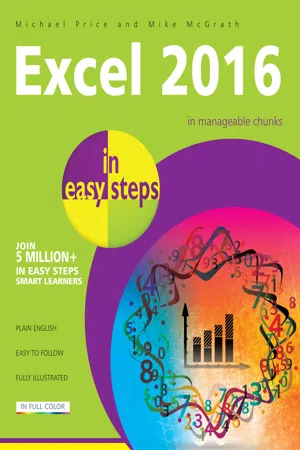
eBook - ePub
Excel 2016 in easy steps
Michael Price, Mike McGrath
This is a test
- English
- ePUB (mobile friendly)
- Available on iOS & Android
eBook - ePub
Excel 2016 in easy steps
Michael Price, Mike McGrath
Book details
Book preview
Table of contents
Citations
About This Book
Excel 2016 in easy steps will help you get to grips with the latest version of this popular spreadsheet application. Areas covered include: Creating, editing and manipulating worksheets
Formulas, Functions and Pivot Tables
Handy templates to give you a head start
Macros for everyday tasks to save time
Charts to get an overview of your data
Linking workbooks for automatic updates
Using the Excel Online app to share and collaborate on spreadsheets and workbooks
Adding images and illustrations to your spreadsheet to impress your colleagues!
Whether you’re upgrading to Excel 2016 or new to the spreadsheet concept, use this guide to learn the key features constructively and get more out of Excel 2016 – in easy steps!
Frequently asked questions
At the moment all of our mobile-responsive ePub books are available to download via the app. Most of our PDFs are also available to download and we're working on making the final remaining ones downloadable now. Learn more here.
Both plans give you full access to the library and all of Perlego’s features. The only differences are the price and subscription period: With the annual plan you’ll save around 30% compared to 12 months on the monthly plan.
We are an online textbook subscription service, where you can get access to an entire online library for less than the price of a single book per month. With over 1 million books across 1000+ topics, we’ve got you covered! Learn more here.
Look out for the read-aloud symbol on your next book to see if you can listen to it. The read-aloud tool reads text aloud for you, highlighting the text as it is being read. You can pause it, speed it up and slow it down. Learn more here.
Yes, you can access Excel 2016 in easy steps by Michael Price, Mike McGrath in PDF and/or ePUB format, as well as other popular books in Informatik & Desktop-Anwendungen. We have over one million books available in our catalogue for you to explore.
Information
Topic
InformatikSubtopic
Desktop-Anwendungen1
Introduction
This chapter shows how the spreadsheet, the electronic counterpart of the paper ledger, has evolved in Excel, taking advantage of the features of the different versions of Microsoft Office, and the Windows operating system.
The Spreadsheet Concept
Microsoft Excel
Microsoft Office 2016
System Requirements
Getting Office 2016
Excel 2016 and Windows 10
The Office 2016 Ribbon
Exploring Excel 2016
Excel Online App
The Spreadsheet Concept
Spreadsheets, in the guise of the accountant’s ledger sheet, have been in use for many, many years. They consisted of paper forms with a two-dimensional grid of rows and columns, often on extra-large paper, forming two pages of a ledger book, for example (hence the term “spread sheet”). They were typically used by accountants to prepare budget or financial statements. Each row would represent a different item, with each column showing the value or amount for that item over a given time period. For example, a forecast for a 30% margin and 10% growth might show:


Ledger sheets pre-date computers and handheld calculators, and have been in use for literally hundreds of years.
Any changes to the basic figures would mean that all the values would have to be recalculated and transcribed to another ledger sheet to show the effect, e.g. for a 20% margin and 60% growth:

To make another change, to show 10% margin and 200% growth, for example, would involve a completely new set of calculations. And, each time, there would be the possibility of a calculation or transcription error creeping in. With the advent of the personal computer, a new approach became possible. Applications were developed to simulate the operation of the financial ledger sheet, but the boxes (known as cells) that formed the rows and columns could store text, numbers, or a calculation formula based on the contents of other cells. The spreadsheet looked the same, since it was the results that were displayed, rather than the formulas themselves. However, when the contents of a cell were changed in the spreadsheet, all the cells whose values depended on that changed cell were automatically recalculated.

The first spreadsheet application was VisiCorp’s VisiCalc (visible calculator). Numerous competitive programs appeared, but market leadership was taken first by Lotus 123, and now by Microsoft Excel.
This new approach allowed a vast improvement in productivity for various activities, such as forecasting. In the second example shown on the previous page, you’d set up the initial spreadsheet using formulas, rather than calculating the individual cell values. A spreadshee...
Table of contents
- Cover
- Title
- Copyright
- Contents
- 1 Introduction
- 2 Begin with Excel
- 3 Manage Data
- 4 Formulas and Functions
- 5 Excel Tables
- 6 Advanced Functions
- 7 Control Excel
- 8 Charts
- 9 Macros in Excel
- 10 Templates and Scenarios
- 11 Links and Connections
- Back Cover